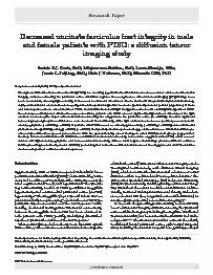Decreased uncinate fasciculus tract integrity in male and female patients with PTSD : a diffusion tensor imaging study.
Background: Posttraumatic stress disorder (PTSD) is a disabling psychiatric disorder that has been associated with lower white matter
integrity of tracts connecting the prefrontal cortex with limbic regions. However, previous diffusion tensor imaging (DTI) findings have
been inconsistent, showing high variability in the exact location and direction of effects. Methods: We performed probabilistic tractography
of the bilateral uncinate fasciculus, cingulum and superior longitudinal fasciculus (both temporal and parietal projections) in male
and female police officers with and without PTSD. Results: We included 38 (21 men) police officers with and 39 (20 men) without PTSD
in our analyses. Compared with trauma-exposed controls, patients with PTSD showed significantly higher mean diffusivity of the right
uncinate
fasciculus, the major white matter tract connecting the amygdala to the prefrontal cortex (p = 0.012). No other significant
between-
group or group × sex differences were observed. Mean diffusivity of the right uncinate fasciculus was positively associated with
anxiety symptoms (r = 0.410, p = 0.013) in patients with PTSD as well as with amygdala activity (r = 0.247, p = 0.038) and ventromedial
prefrontal cortex (vmPFC) activity (r = 0.283, p = 0.016) in all participants in response to happy and neutral faces. Limitations: Our specific
sample of trauma-exposed police officers limits the generalizability of our findings to other PTSD patient groups (e.g., civilian
trauma). Conclusion: Patients with PTSD showed diminished structural connectivity between the amygdala and vmPFC, which was correlated
with higher anxiety symptoms and increased functional activity of these brain regions. Our findings provide additional evidence
for the prevailing neurocircuitry model of PTSD, postulating that ineffective communication between the amygdala and vmPFC underlies
decreased top–down control over fear responses.
In: Journal of psychiatry and neuroscience, ISSN 1180-4882 | 42 | 5 | September | 331-342.
http://jpn.ca/wp-content/uploads/2017/04/42-4-160129.pdf


